Submitted:
01 March 2024
Posted:
04 March 2024
You are already at the latest version
Abstract
Keywords:
1. Introduction
2. Literature Review
- Some studies allow solutions with potential vehicle conflicts during the strategic planning phase in order to speed-up the results;
- Many tow truck-based taxiing solutions focus solely on identifying conflict-free routes and schedules, neglecting efficient allocation of tow trucks, such as minimising taxi delays or maximising fuel savings;
- Existing performance metrics are often limited to taxi delays and number of potential vehicle conflicts. Additional metrics, such as fuel consumption and fuel savings, could highlight the potential environmental benefits of tow trucks;
- The taxiing solutions presented are typically tested on single airport layouts. This does not guarantee their applicability to airports of varying sizes and layouts;
- Performance evaluations of taxiing algorithms are frequently conducted using a single medium-level traffic scenario. This approach, while useful for initial testing, fails to assess the system’s robustness across different traffic levels;
- Performance evaluations commonly employ a fixed number of tow trucks, discarding potential variation in tow truck numbers;
- State-of-charge of tow truck batteries is often overlooked during scheduling. This approach potentially skews the tow truck performance and underestimates the number of tow trucks required for taxi operations.
3. Description of Algorithm
3.1. Airport Modelling and Assumptions
3.2. Flight Dispatcher
- and are input to the module Path Finder, which finds the ideal (i.e. shortest) path and the ideal (i.e. shortest) taxi distance. This distance is then divided by to find an ideal taxi time ;
- The module attempts to find a conflict-free solution. First, the ideal path is forwarded to the Conflict Detector module. This module checks if the path is conflict-free; produces a Vehicle Occupation Table (VOT), which stores all the time windows during which the edges of the path are occupied by the vehicle; and, if potential conflicts are detected, stores them in the Edges in Conflict List (ECL), which contains a list of edges that need to be excluded from the next iteration of Path Finder;
- If potential conflicts are detected, Path Finder calculates a new path, excluding the edges listed in ECL, and the feasibility of the path – indicating whether the module found a feasible path (i.e. and are connected by a number of edges) – is checked. If the path is not feasible, the solution is discarded and the process restarts with an incremented (see point 5.); otherwise, the feasible path is sent again to the Conflict Detector to check for the presence of conflicts. This process is repeated until a conflict-free path is identified or, as mentioned, until the path is flagged as not feasible. In case a conflict-free path is found, the module calculates and stores of the current iteration;
- is incremented by a time interval equal to 10 s (i.e. with the same duration of a time window) and the process is repeated from point 2. for a new iteration;
- New solutions are calculated until the of a new solution is greater than or equal to the of any solution, in which case the search for solutions is stopped for the analysed runway. The whole process is repeated for the next runway until all the LEPs (in case of an arrival) or all the ToPs (in case of a departure) are analysed;
- In case no conflict-free solutions are found (meaning that all of the solutions are discarded because the corresponding paths are considered to be unfeasible), the whole set of solutions is marked as unfeasible and the algorithm stops the calculations for the selected simulation;
- The solution with the lowest is selected and the VOT of the selected solution is appended to the Global Occupation Table (GOT), which represents the combination of all the VOTs of the selected solutions of the previously analysed aircraft; therefore, when the first aircraft is analysed, the GOT is empty.
3.3. Tug Dispatcher
- Static and Dynamic Allocation of Tow Trucks
- 2.
- Tow Trucks Allocation Criteria
- Availability of a conflict-free route from the tow truck’s location to the aircraft’s that permits the tow truck to reach the aircraft exactly at the of the aircraft;
- If multiple tow trucks meet the first criterion, the tow truck with the lowest associated Total Mission Cost (given by Eq. (3)) is chosen;
- If more than one tow truck has the lowest associated cost as defined in the second criterion, the tow truck with the least utilisation time is selected to ensure a fair distribution of missions between the tow trucks.
- 3.
- Time-Wise and Fuel-Wise Approach
- -
- Time-Wise Approach: In this approach, no tow trucks are assigned to the flight, and the aircraft is permitted to taxi with its own engines.
- 4.
- Depot Allocation Criteria
- A conflict-free route exists from the final position of the assigned aircraft, , to the depot under consideration.
- The depot under consideration has at least one available parking slot at the time the tow truck is scheduled to arrive.
- The time required to return to the depot under consideration is shorter than the time needed to return to any other depot.
- 5.
- Battery Discharge Rates
- The Higher Battery Discharging Rate () is the battery discharge rate applied when the tow truck is in motion and loaded and is set equal to 2%/minute.
- The Lower Battery Discharging Rate () is the battery discharge rate applied when the tow truck is in motion and unloaded and is set equal to 1%/minute.
- The Battery Charging Rate () is the recharge rate applied when the tow truck is at a charging point in a depot and is set equal to 2%/minute.
4. Testing and Results
4.1. Performance Metrics
4.2. Airport Selection
- -
- Malta International Airport (MLA): Relatively small in size.
- -
- Ben Gurion Airport (TLV): Medium-sized, featuring a unique layout of the runways.
- -
- Toulouse–Blagnac Airport (TLS): Medium-sized, with a classic layout of runways.
4.3. Test Scenarios
4.4. Test Results
- Results for Test Scenario 1
- 2.
- Results for Test Scenario 2
- 3.
- Results for Test Scenario 3
- 4.
- Results for Test Scenario 4
- 5.
- Results for Test Scenario 5
- 6.
- Results for Test Scenario 6
5. Conclusions and Future Work
5.1. Conclusions
5.2. Potential Areas of Future Work
Nomenclature
| OBT | = | Off-Block Time (-) |
| TOA | = | Time of Arrival (-) |
| = | number of parking slots at a depot (-) | |
| = | total number of tow trucks (-) | |
| = | total number of depots (-) | |
| ToP | = | Takeoff Point (-) |
| LEP | = | Landing Point (-) |
| = | Average Vehicle Velocity (m/s) | |
| = | Buffer Area (m2) | |
| = | Buffer Distance (m) | |
| = | aircraft (-) | |
| = | (-) | |
| = | (-) | |
| = | time to start taxiing | |
| = | Total Delay (s) | |
| = | delay experienced by an aircraft while waiting (s) | |
| = | delay accumulated by an aircraft while taxiing (s) | |
| = | ideal taxi time (s) | |
| VOT | = | Vehicle Occupation Table (-) |
| ECL | = | Edges in Conflict List (-) |
| GOT | = | Global Occupation Table (-) |
| = | Total Mission Cost (s) | |
| = | tow truck (-) | |
| = | needs to complete the mission (-) | |
| = | over all the tow trucks (s) | |
| = | maximum battery charge (%) | |
| = | minimum allowed battery charge (%) | |
| = | (%) | |
| = | Higher Battery Discharging Rate (%) | |
| = | Lower Battery Discharging Rate (%) | |
| = | Battery Charging Rate (%) | |
| = | Average Total Delay (s) | |
| = | Delayed Aircraft (%) | |
| = | Towed Aircraft (%) | |
| = | Average Fuel Savings (kg) | |
| = | Average Tow Trucks Utilisation Time (%) |
| 1 | In practice, the exact takeoff/landing point depends on multiple factors such as: the takeoff/landing distance required; wind speed and direction; runway conditions; etc. |
References
- "www.eurocontrol.int," Eurocontrol, 10 March 2023. [Online]. Available: https://www.eurocontrol.int/publication/eurocontrol-data-snapshot-40-taxi-times#:~:text=Typically%2C%20flying%20from%20one%20of,time%20of%20over%2020%20minutes. [Accessed 12 May 2023].
- M. Zhang, Q. Huang, S. Liu and H. Li, "Assessment Method of Fuel Consumption and Emissions of Aircraft during Taxiing on Airport Surface under Given Meteorological Conditions," College of Civil Aviation, Nanjing University of Aeronautics and Astronautics, Nanjing, China, 2019.
- T. Nikoleris, G. Gupta and M. Kistler, "Detailed estimation of fuel consumption and emissions during aircraft taxi operations at Dallas/Fort Worth International Airport," Transportation Research Part D, Elsevier, 2011.
- N. Dzikus, J. Fuchte, A. Lau and V. Gollnick, "Potential for Fuel Reduction through Electric Taxiing," in 11th AIAA Aviat. Technol. Integr. Oper. Conf., 2011.
- E. Fleuti and S. Maraini, "Taxi-Emissions at Zurich Airport," 2017.
- "op.europa.eu," European Commission, 2011. [Online]. Available: https://op.europa.eu/en/publication-detail/-/publication/296a9bd7-fef9-4ae8-82c4-a21ff48be673. [Accessed 15 March 2023].
- "ec.europa.eu," European Commission, 2020. [Online]. Available: https://ec.europa.eu/clima/policies/transport/aviation_en. [Accessed 15 March 2023].
- "www.iata.org," International Air Transport Association, December 2022. [Online]. Available: https://www.iata.org/en/iata-repository/pressroom/fact-sheets/fact-sheet---fuel/. [Accessed 4 April 2023].
- "www.fitchratings.com," Fitch Ratings, 25 February 2022. [Online]. Available: https://www.fitchratings.com/research/corporate-finance/oil-price-shock-is-a-material-risk-for-us-european-airlines-25-02-2022. [Accessed 4 April 2023].
- "www.statista.com," Statista, 2023. [Online]. Available: https://www.statista.com/statistics/591285/aviation-industry-fuel-cost/. [Accessed 4 April 2023].
- WheelTug, [Online]. Available: https://www.wheeltug.com/. [Accessed 15 March 2023].
- "tec.ieee.org," IEEE TRansportation Electrification Community, 2014. [Online]. Available: https://tec.ieee.org/newsletter/march-april-2014/electric-green-taxiing-system-egts-for-aircraft. [Accessed 15 March 2023].
- "TaxiBot," 2020. [Online]. Available: https://www.taxibot-international.com/. [Accessed 15 March 2023].
- P. H. Abreu and E. Oliveira, "Comparing a Centralized and Decentralized Multi-Agent Approaches to Air Traffic Control," 2014.
- Y. J. Chiang, J. T. Klotowski, C. Lee and J. S. B. Mitchell, "Geometric algorithms for conflict detection/resolution in air traffic management," in 36th IEEE Conference on Decision and Control, San Diego, California, USA, 2004.
- X. Wang, H. Peng, J. Liu, X. Dong, X. Zhao and C. Lu, "Optimal control based coordinated taxiing path planning and tracking for multiple carrier aircraft on flight deck," Defence Technology, February 2022.
- H. Udluft, "Decentralization in Air Transportation," Delft, Netherland, 2017.
- R. Morris, M. L. Chang, R. Archer, E. V. I. Cross, S. Thompson, J. L. Franke, R. C. Garrett, W. Malik, K. McGuire and G. Hermann, "Self-Driving Aircraft Towing Vehicles: A Preliminary Report," Austin, Texas, USA, 2015.
- R. Morris, M. L. Chang, R. Archer, E. V. Cross II, S. Thompson, J. Franke, R. C. Garrett, C. Pasareanu, W. Malik and G. Hemann, "SafeTug Semi-Autonomous Aircraft Towing Vehicles," NASA, 2016.
- Vemula, K. Muelling and J. Oh, "Path Planning in Dynamic Environments with Adaptive Dimensionality," Robotics Institute, Carnegie Mellon University, Pittsburgh, Pennsylvania, USA, 2016.
- E. Gawrilow, E. Köhler, R. H. Möhring and B. Stenzel, "Dynamic Routing of Automated Guided Vehicles in Real-time," Institut für Mathematik, Technische Universität Berlin, Berlin, Germany, 2007.
- M. Zhang, Q. Huang and H. Li, "Multi-Objective Optimization of Aircraft Taxiing on the Airport Surface with Consideration to Taxiing Conflicts and the Airport Environment," College of Civil Aviation, Nanjing University of Aeronautics and Astronautics, Nanjing, China, 2019.
- J. Montoya, W. Zachary, S. Rathinam and W. Malik, "A Mixed Integer Linear Program for Solving a Multiple Route Taxi Scheduling Problem," NASA Ames Research Center, Moffett Field, California, USA, 2010.
- L. Adacher, M. Flamini and E. Romano, "Rerouting Algorithms Solving the Air Traffic Congestion," Università degli studi Roma Tre, Rome, Italy, 2017.
- L. Li and G. Jiawei, "Research on aircraft taxiing path optimization based on digraph model and Dijkstra algorithm," in IOP Conference Series Materials Science and Engineering, 2021.
- M. F. Ibrahim, A. Z. A. Bakar and A. Hussain, "Genetic Algorithm-based Robot Path Planning," Department of Electrical, Electronics and Systems Engineering, Universiti Kebangsaan Malaysia, Bangi, Selangor, Malaysia, 2009.
- R. Jordan, M. A. Ishutkina and T. G. Reynolds, "A Statistical Learning Approach to the Modeling of Aircraft Taxi TIme," in Digital Avionics Systems Conference, Salt Lake City, Utah, USA, 2010.
- L. Yang, Y. Suwan, K. Han, J. Haddad and H. M., "Fundamental diagrams of airport surface traffic: Models and applications," Transportation Research Part B: Methodological, 2017.
- H. Khadilkar and H. Balakrishnan, "Estimation of Aircraft Taxi-out Fuel Burn using Flight Data Recorder Archives," Massachusetts Institute of Technology, Cambridge, Massachusetts, USA, 2011.
- "ACI World," Airports Council International, 2022. [Online]. Available: https://aci.aero/2022/04/11/the-top-10-busiest-airports-in-the-world-revealed/. [Accessed 27 April 2023].
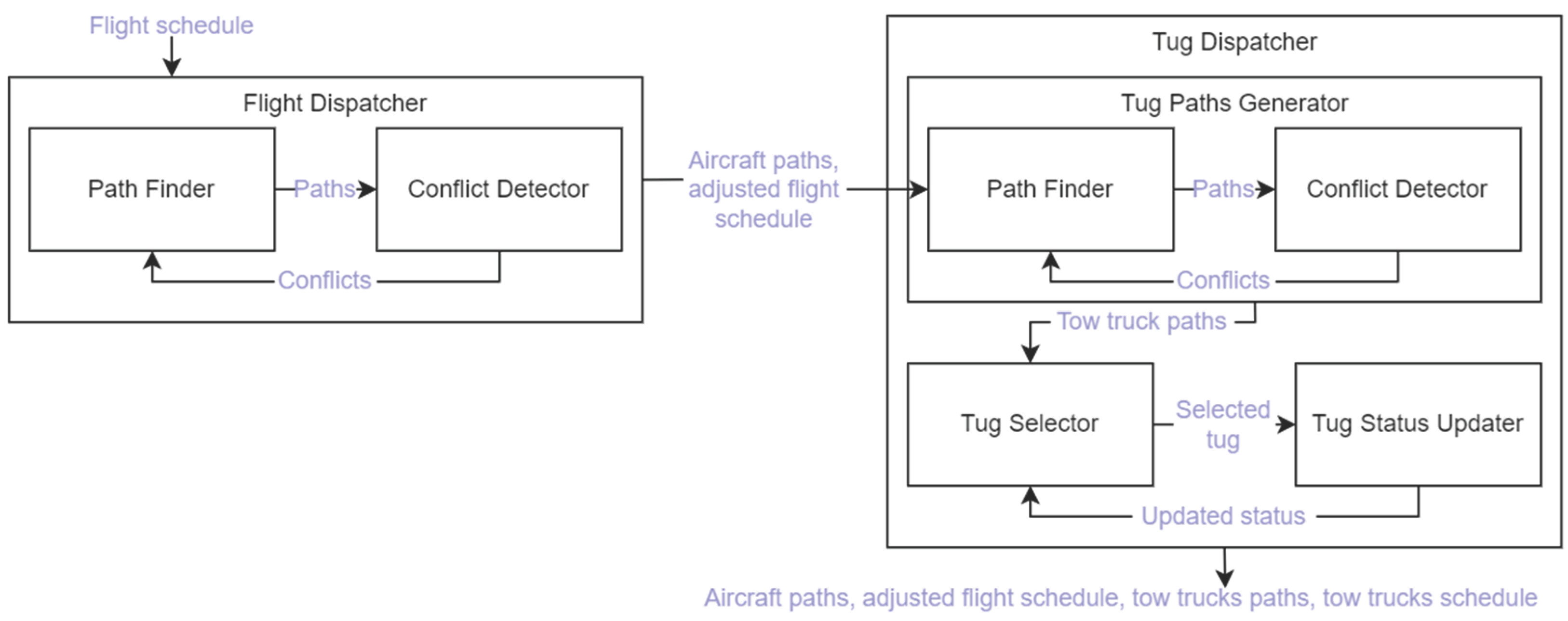
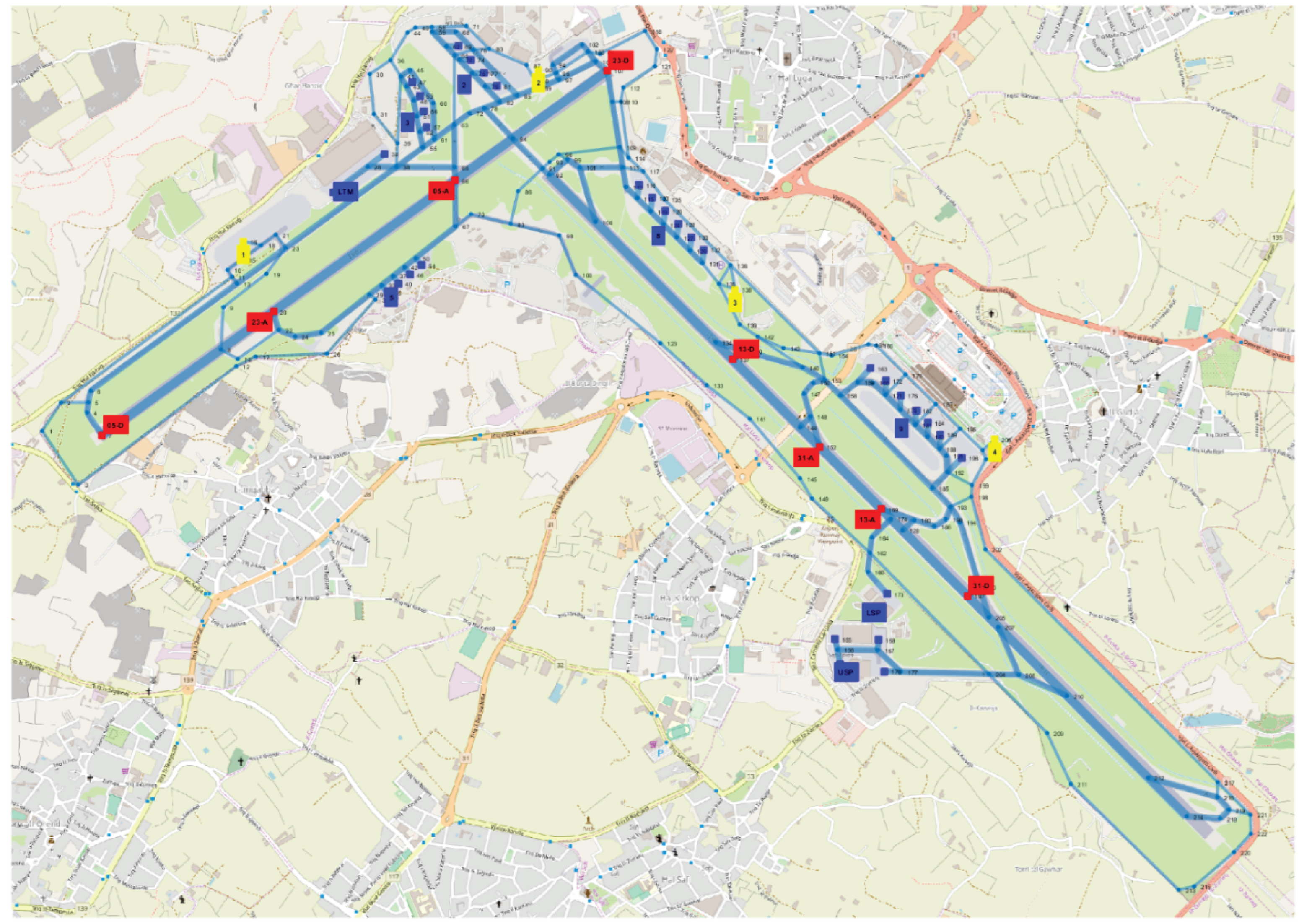
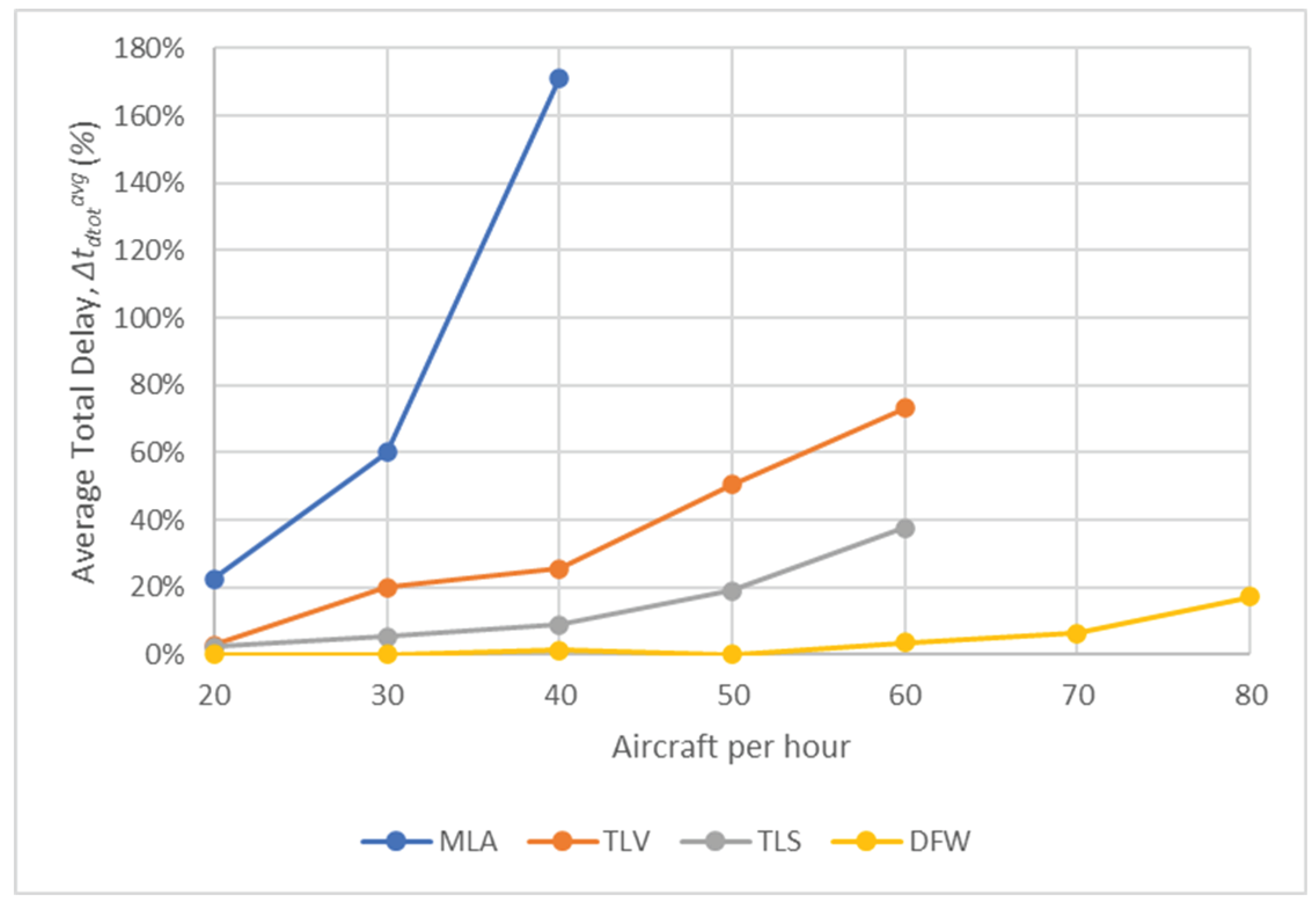
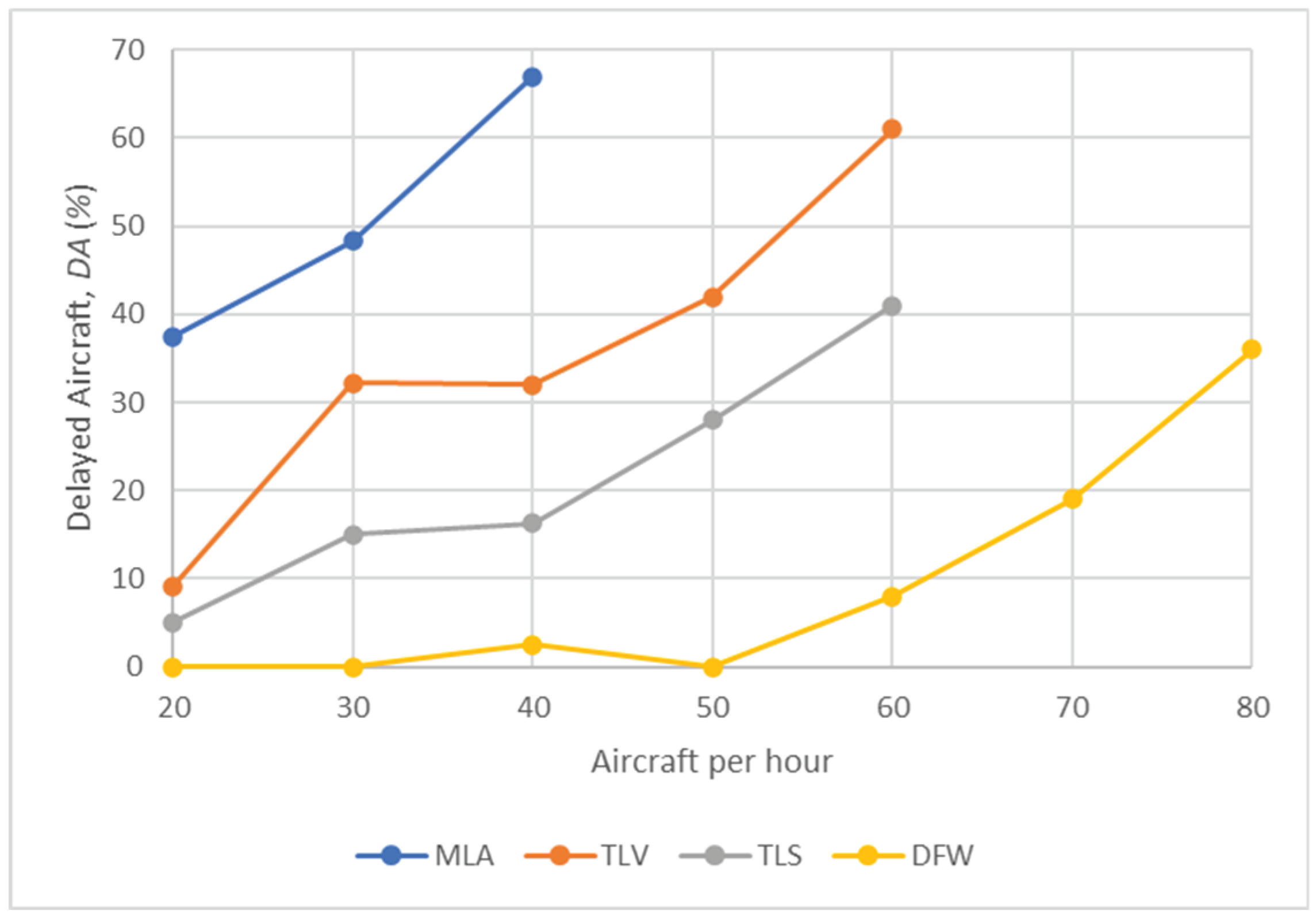
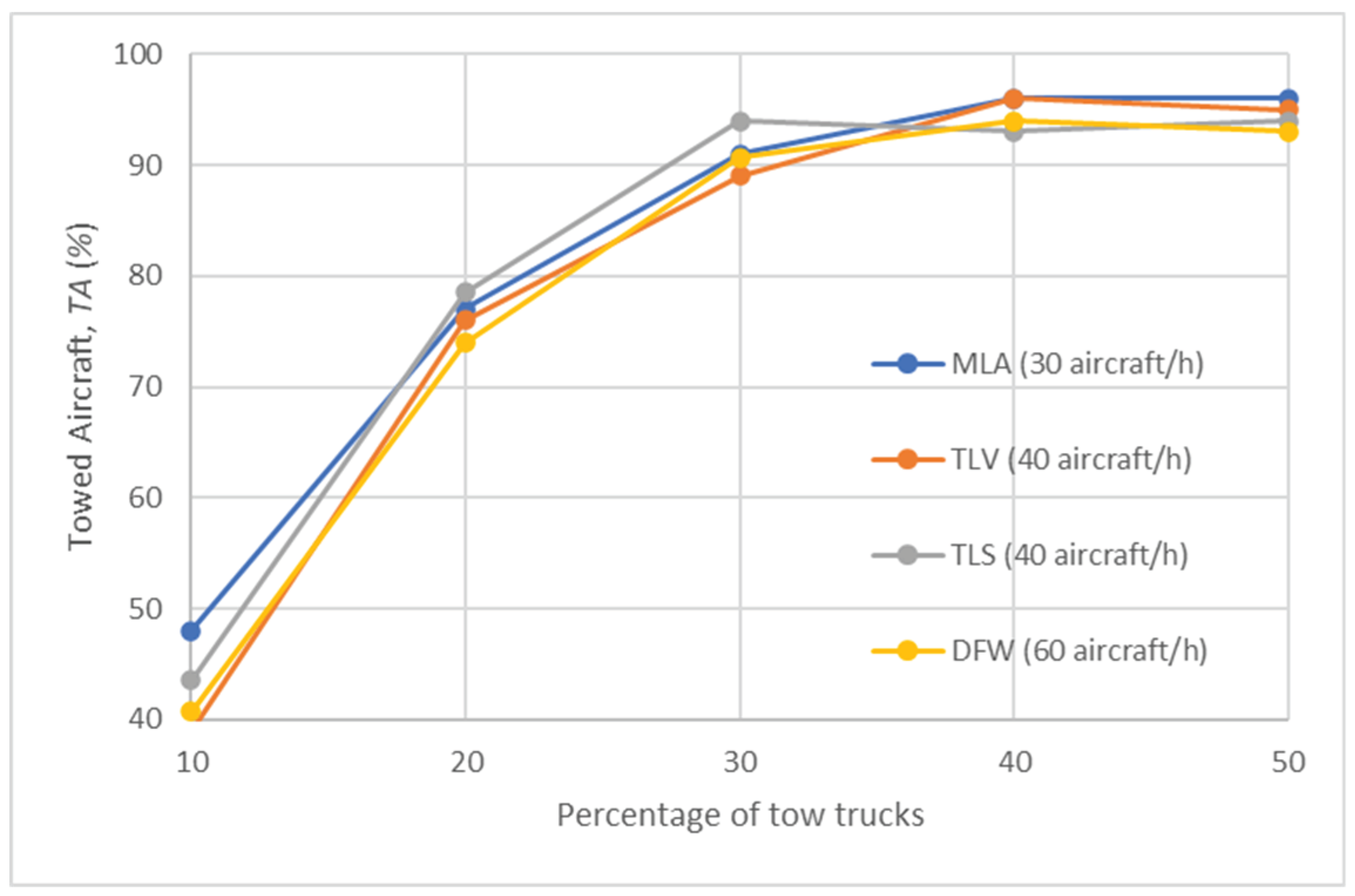
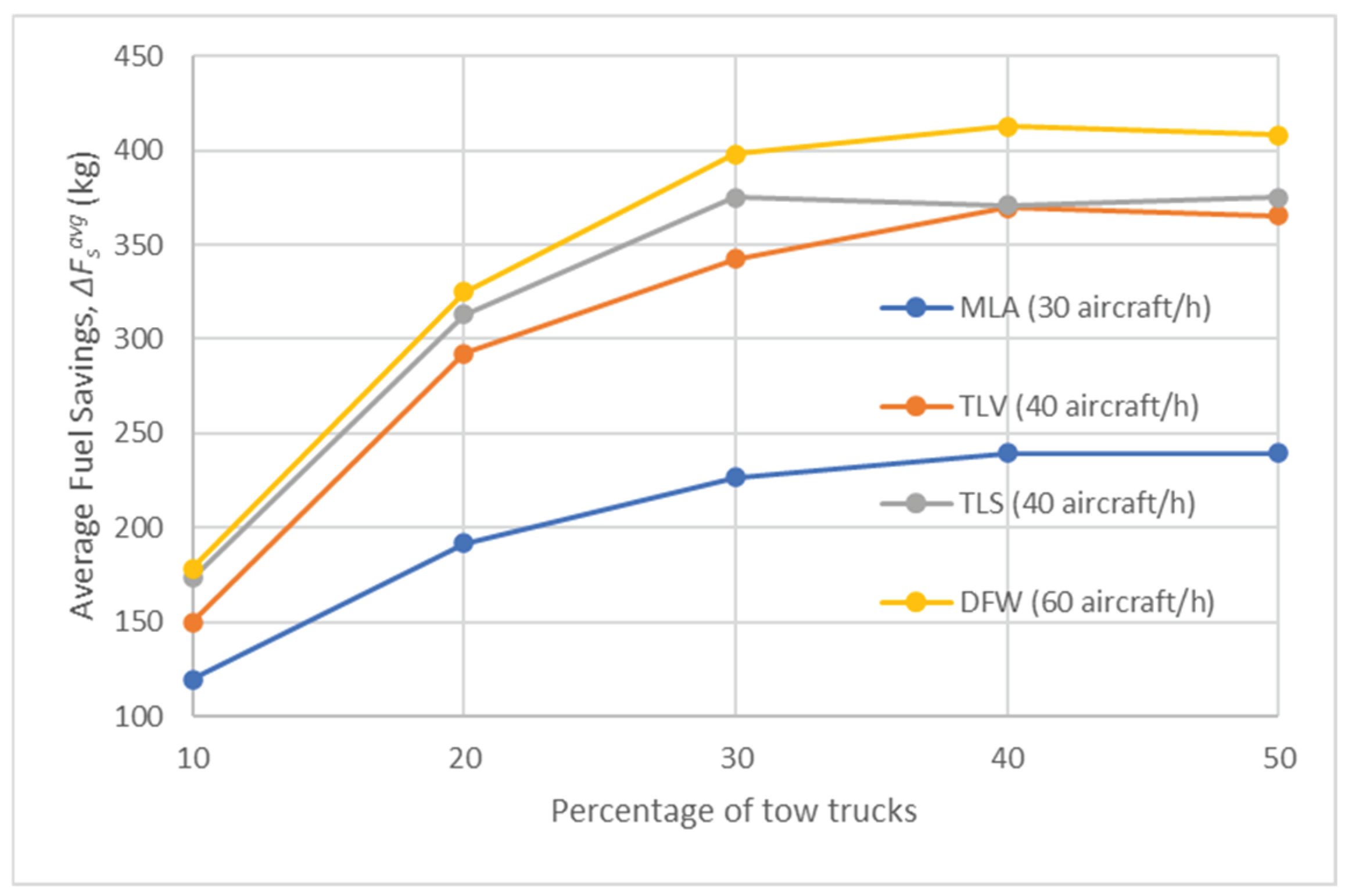
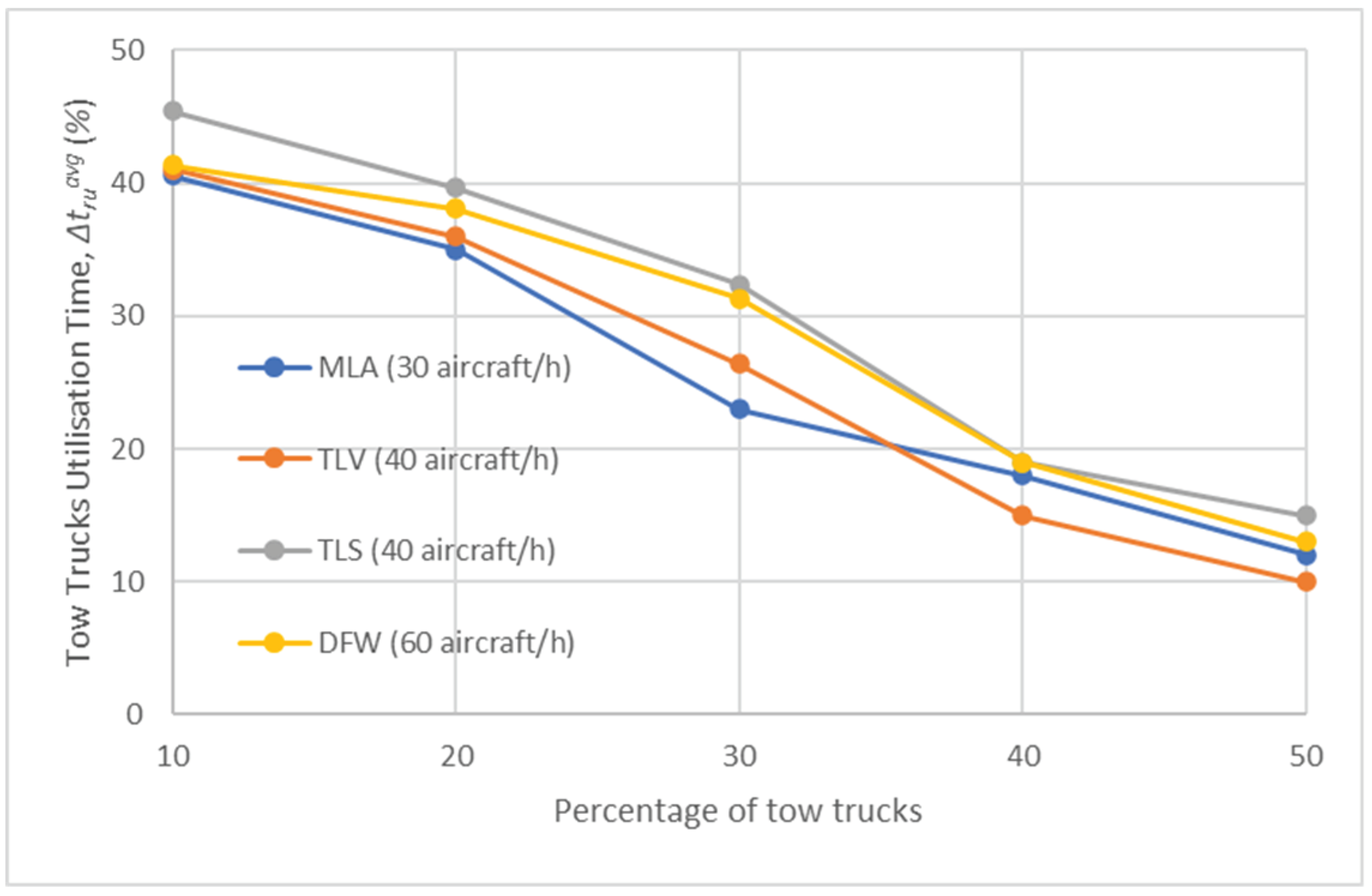
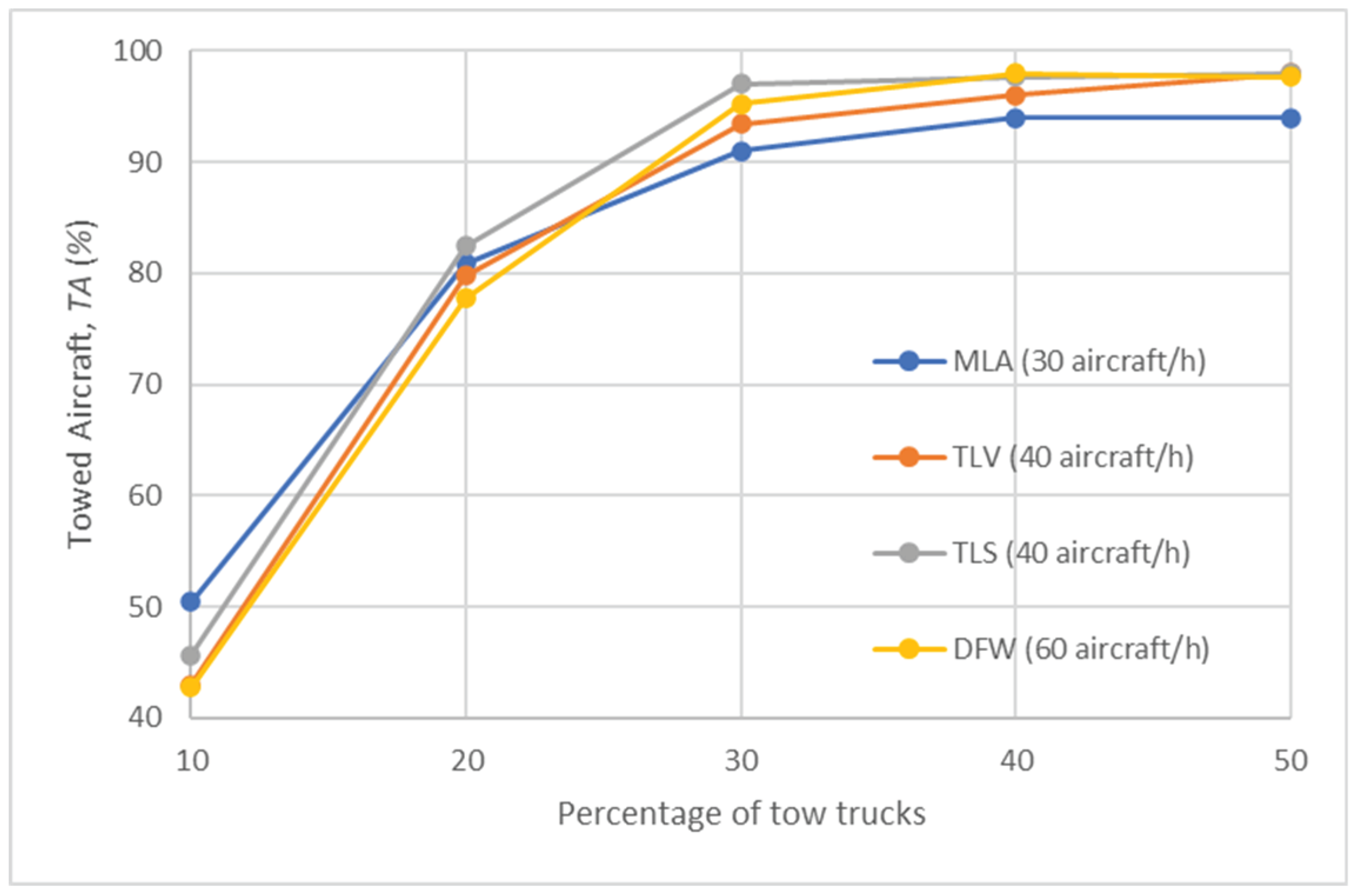
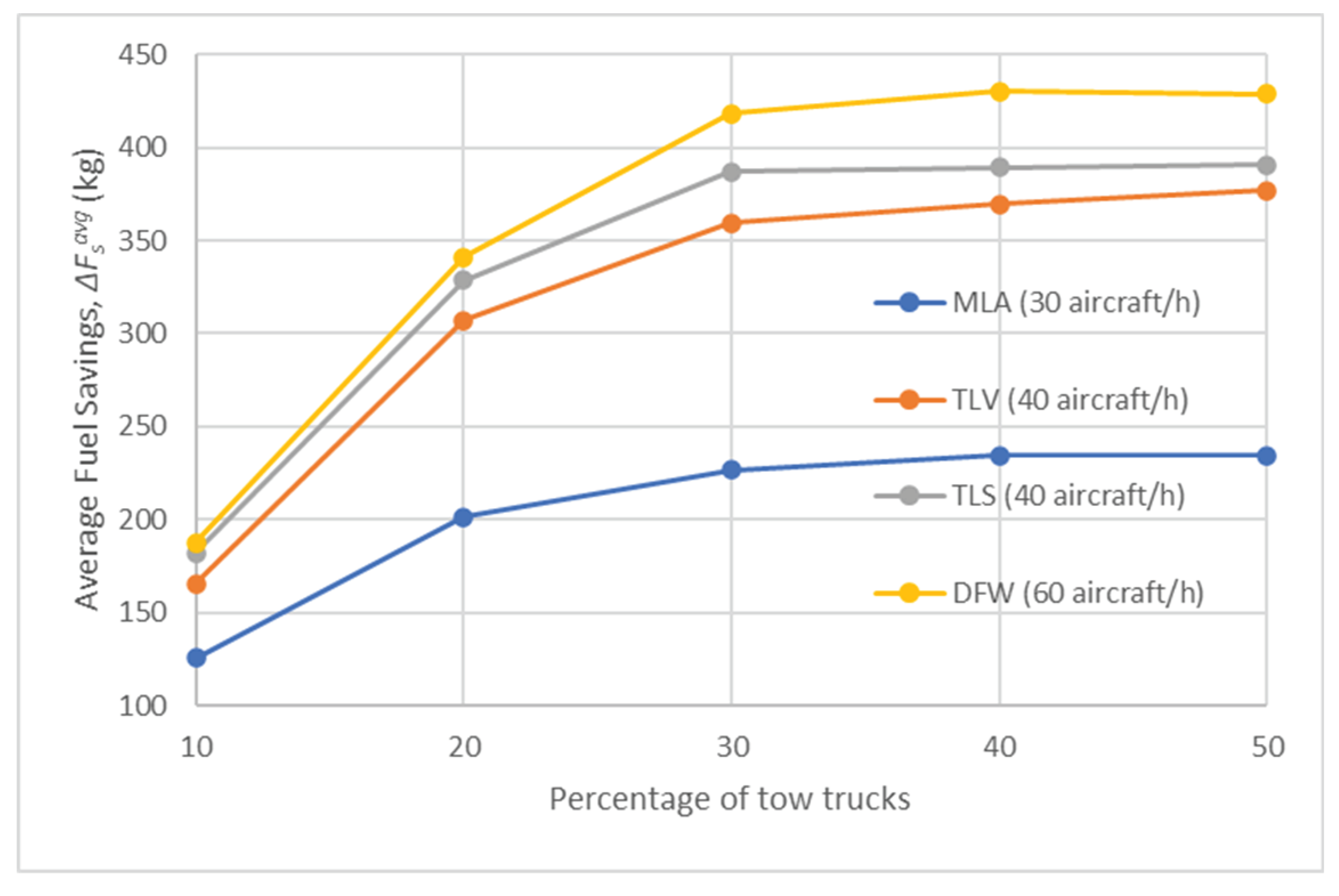
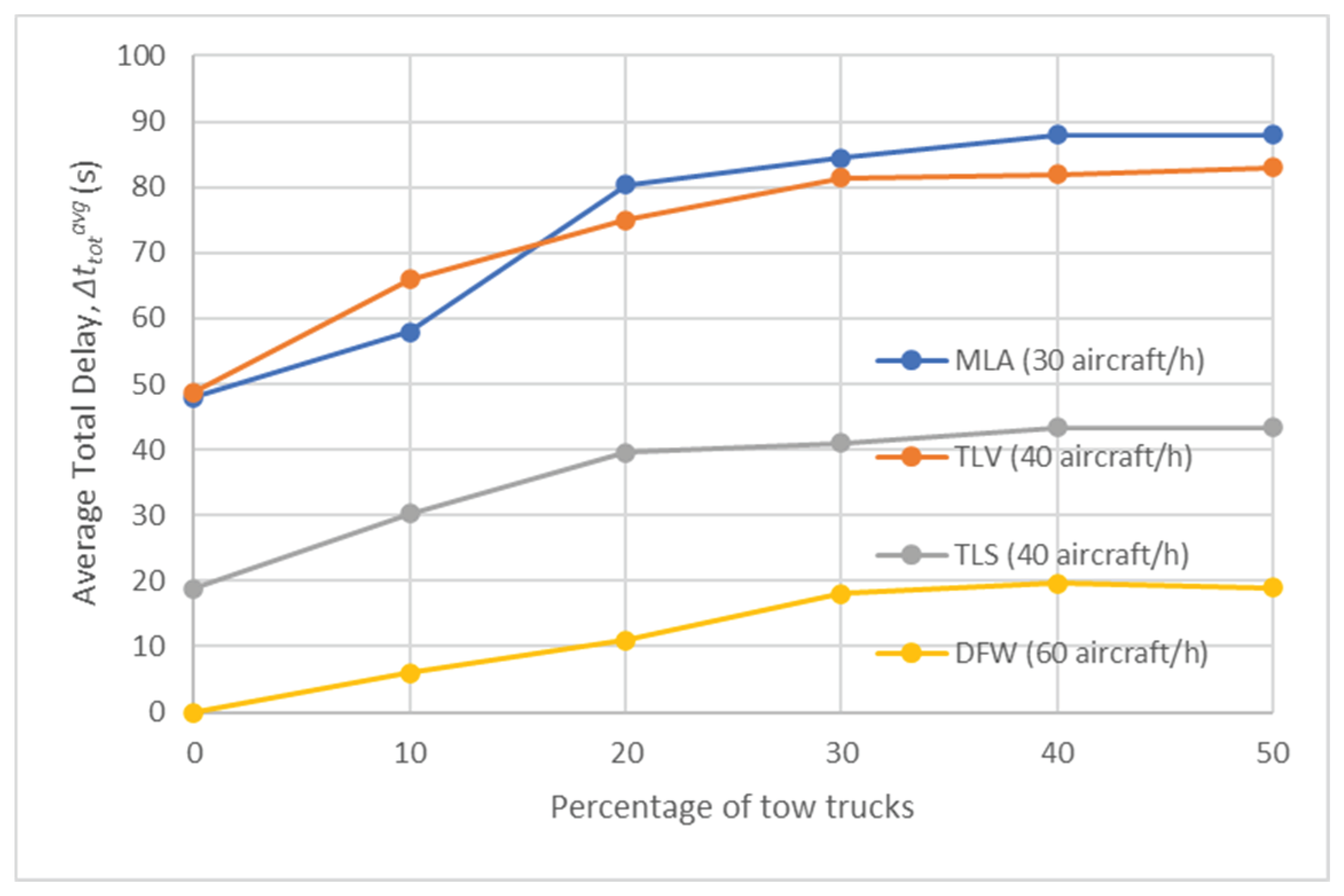

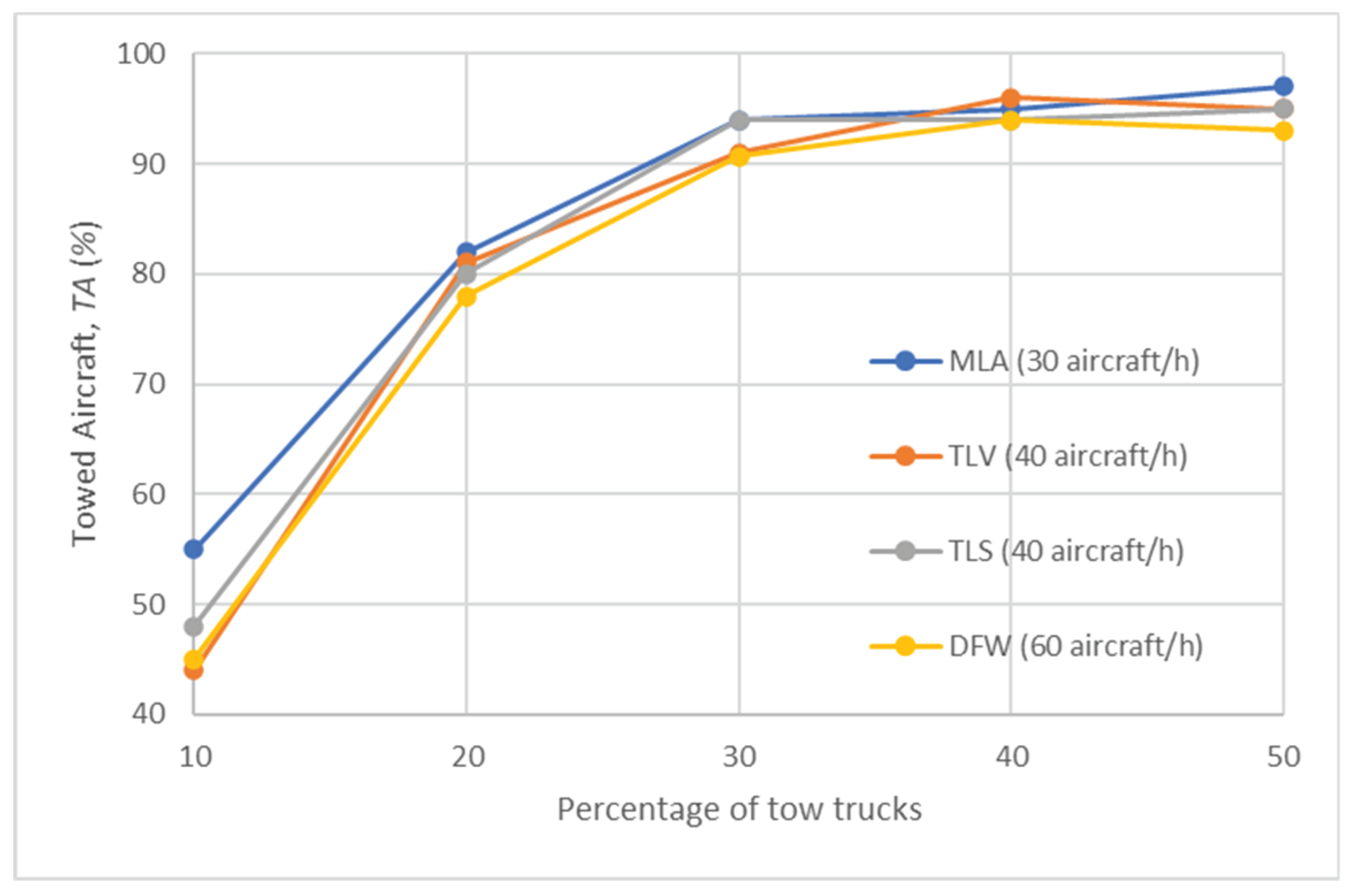
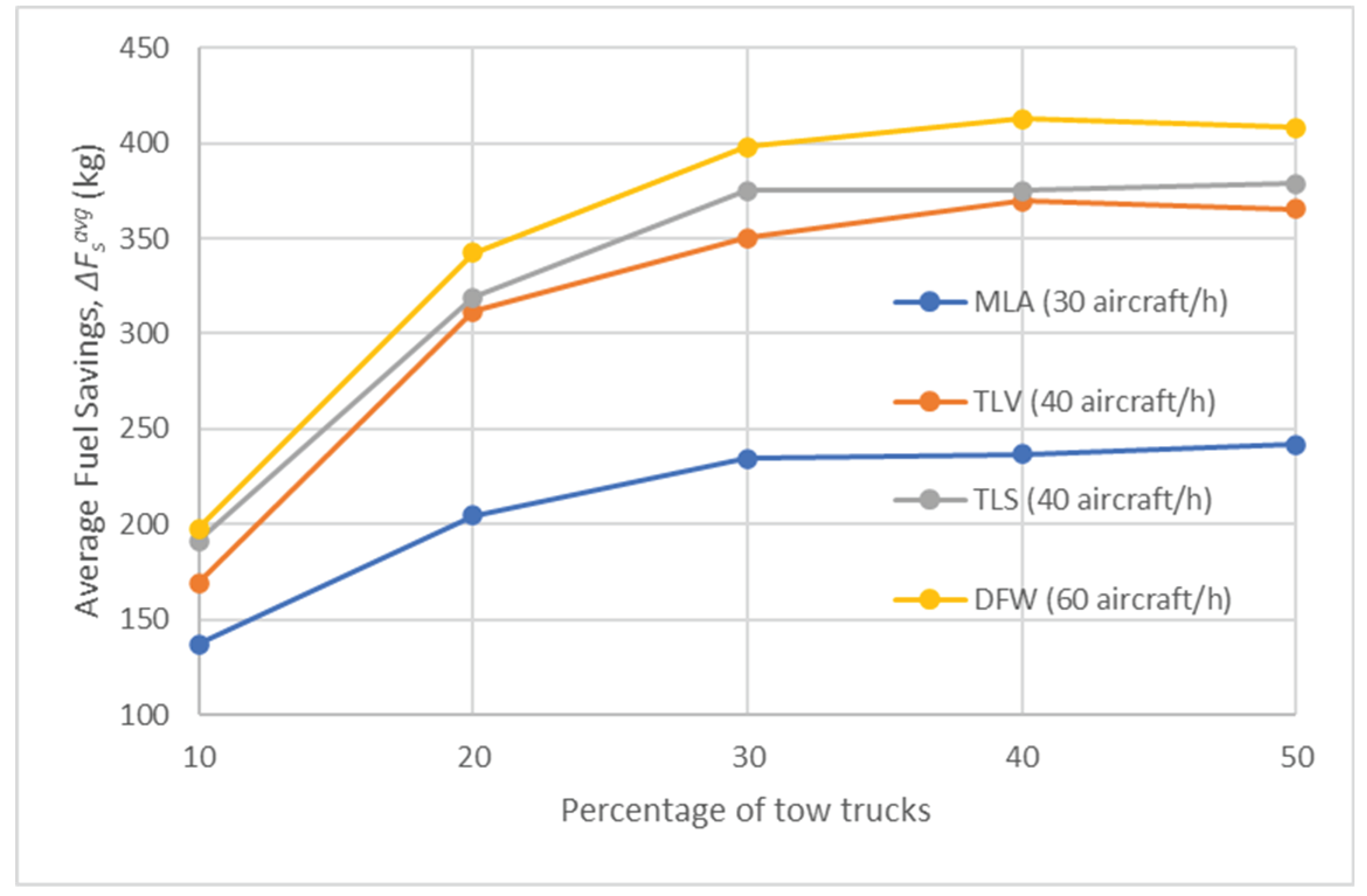
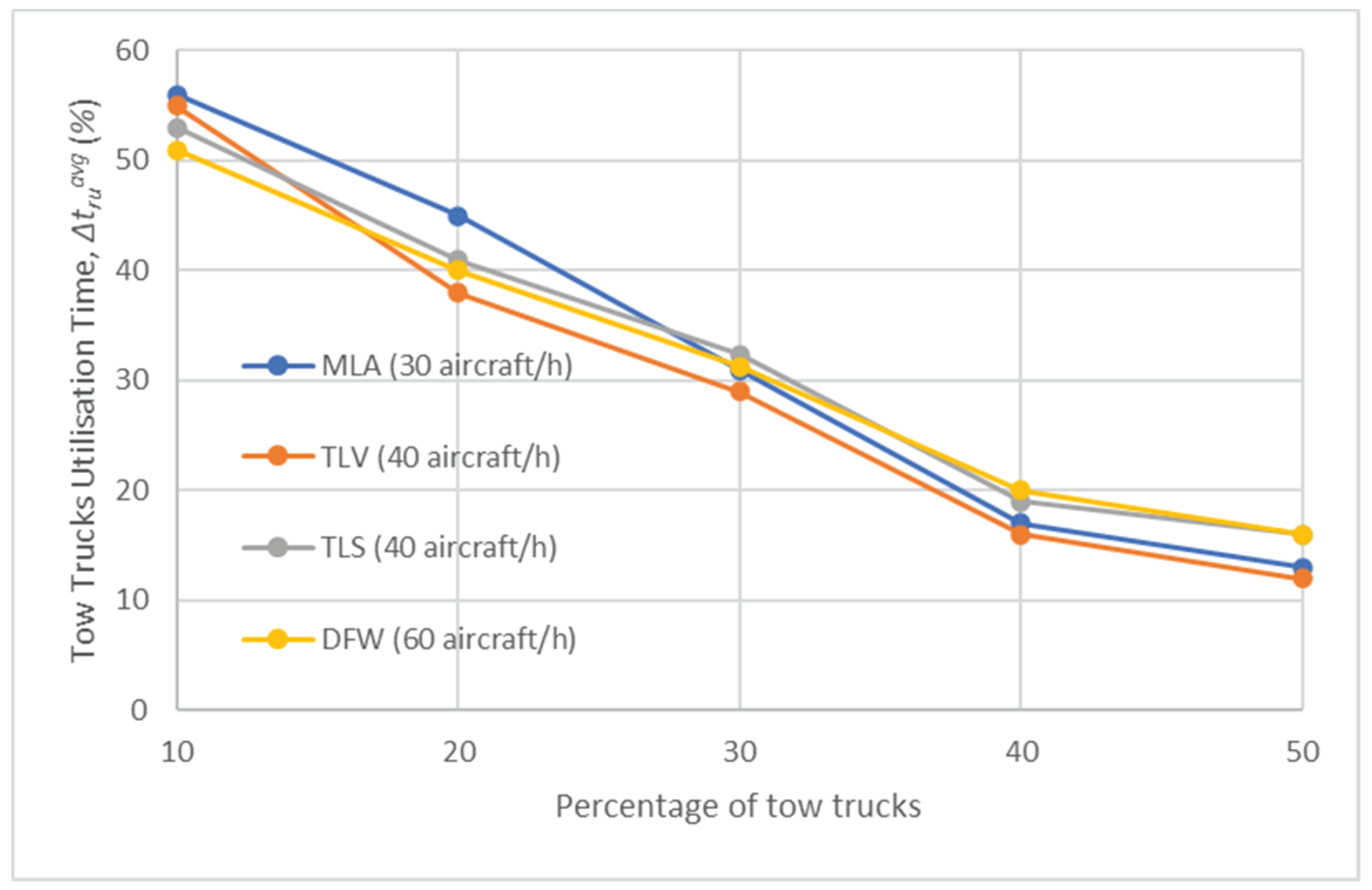
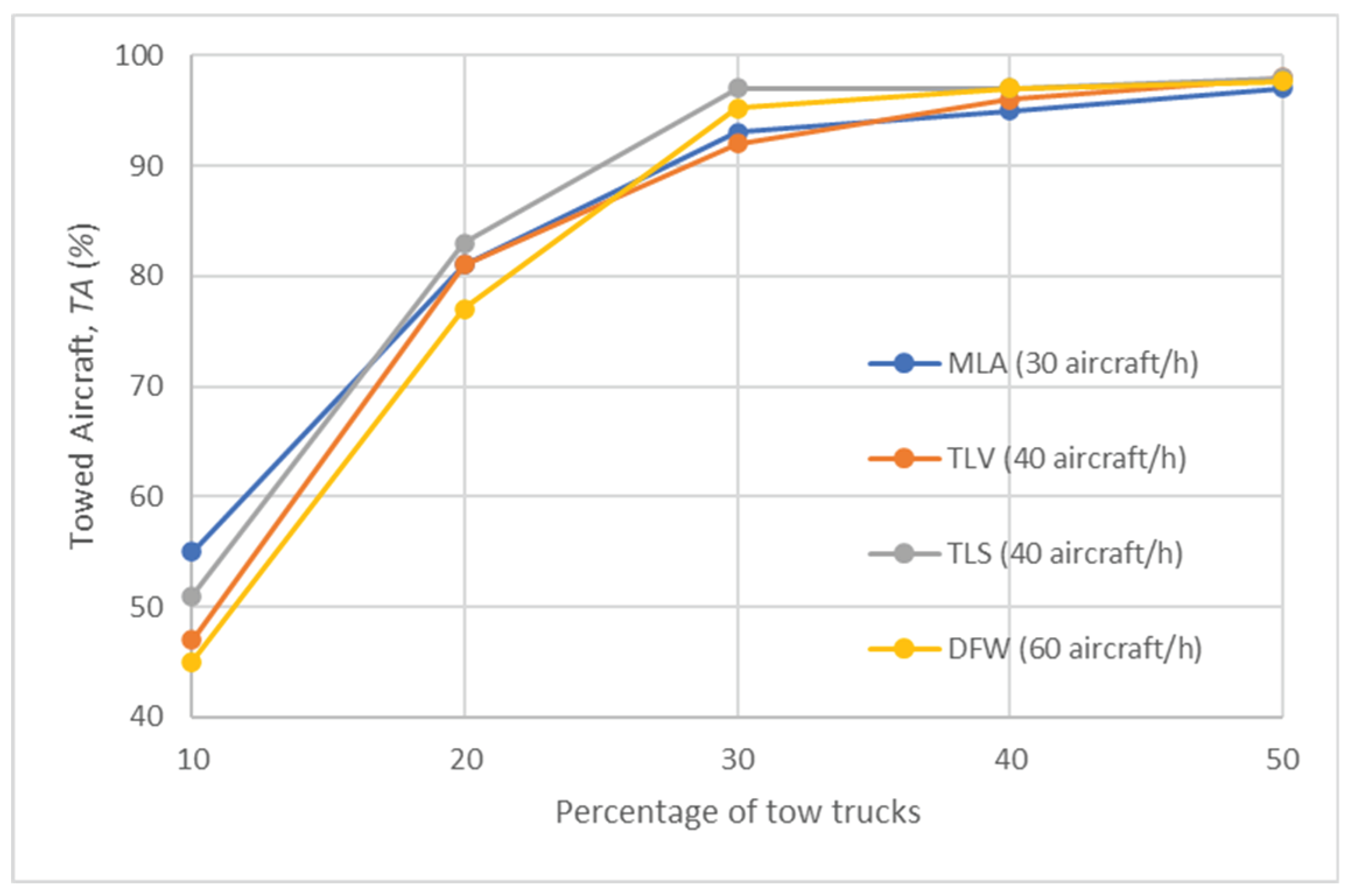
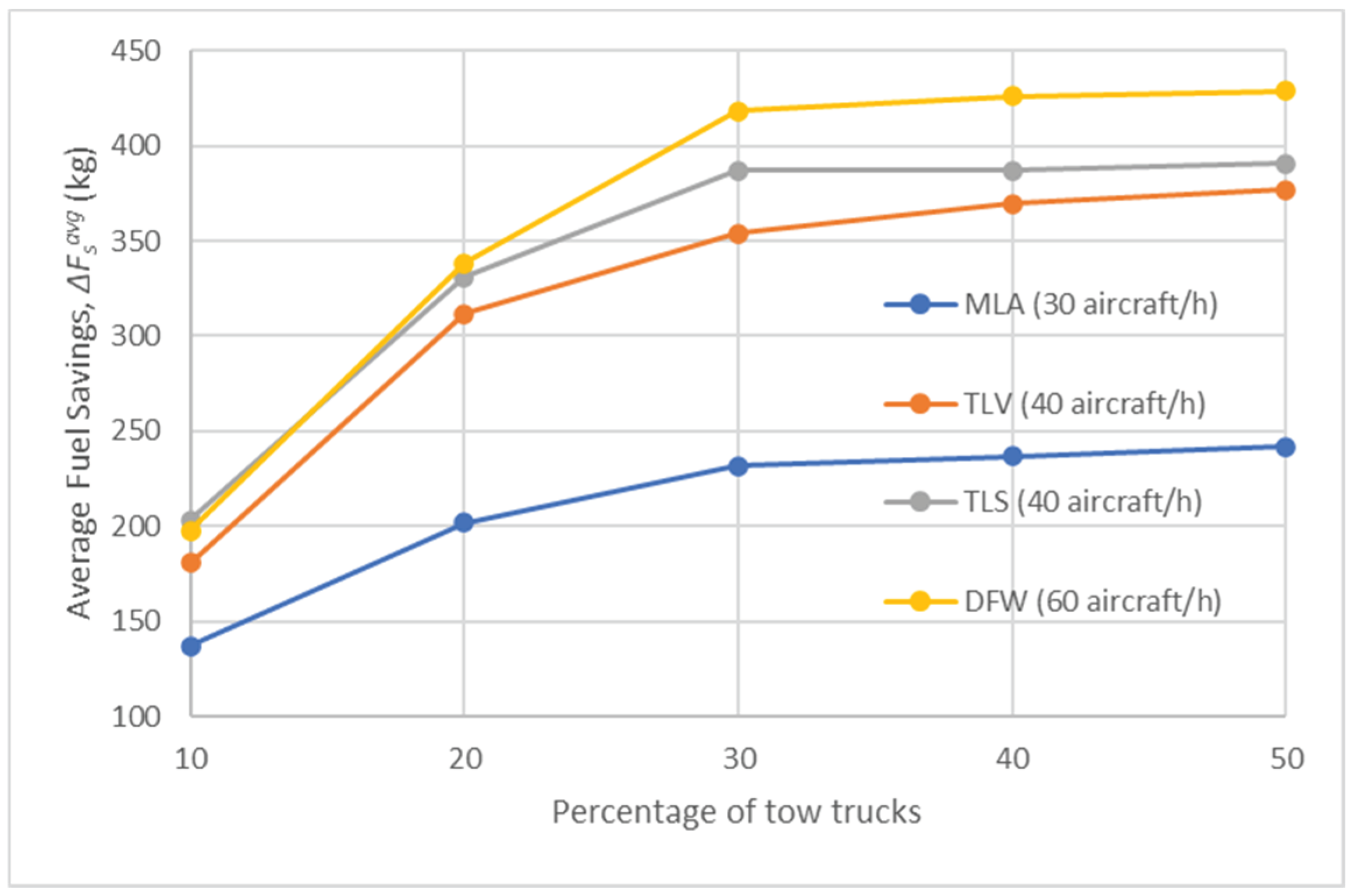
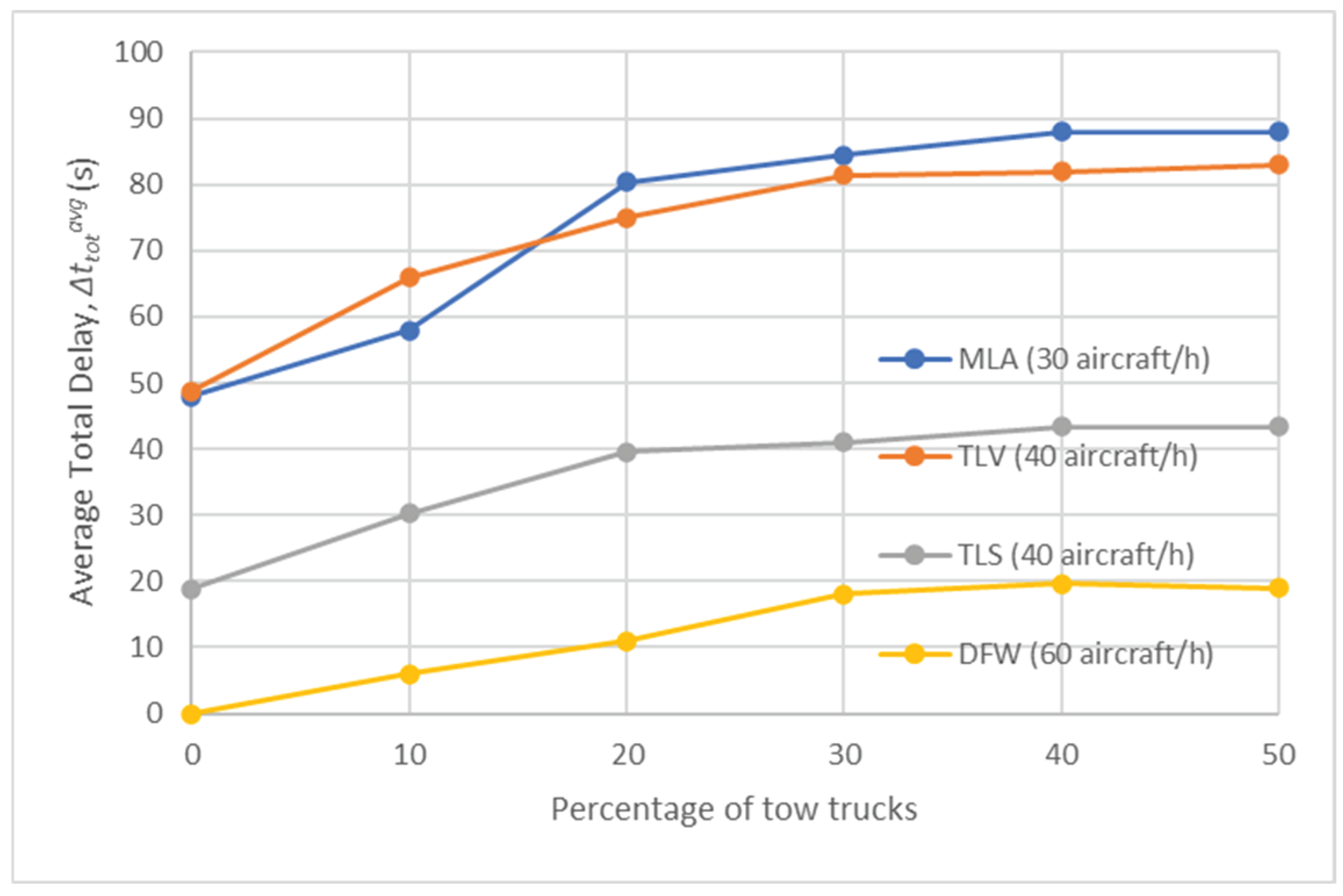
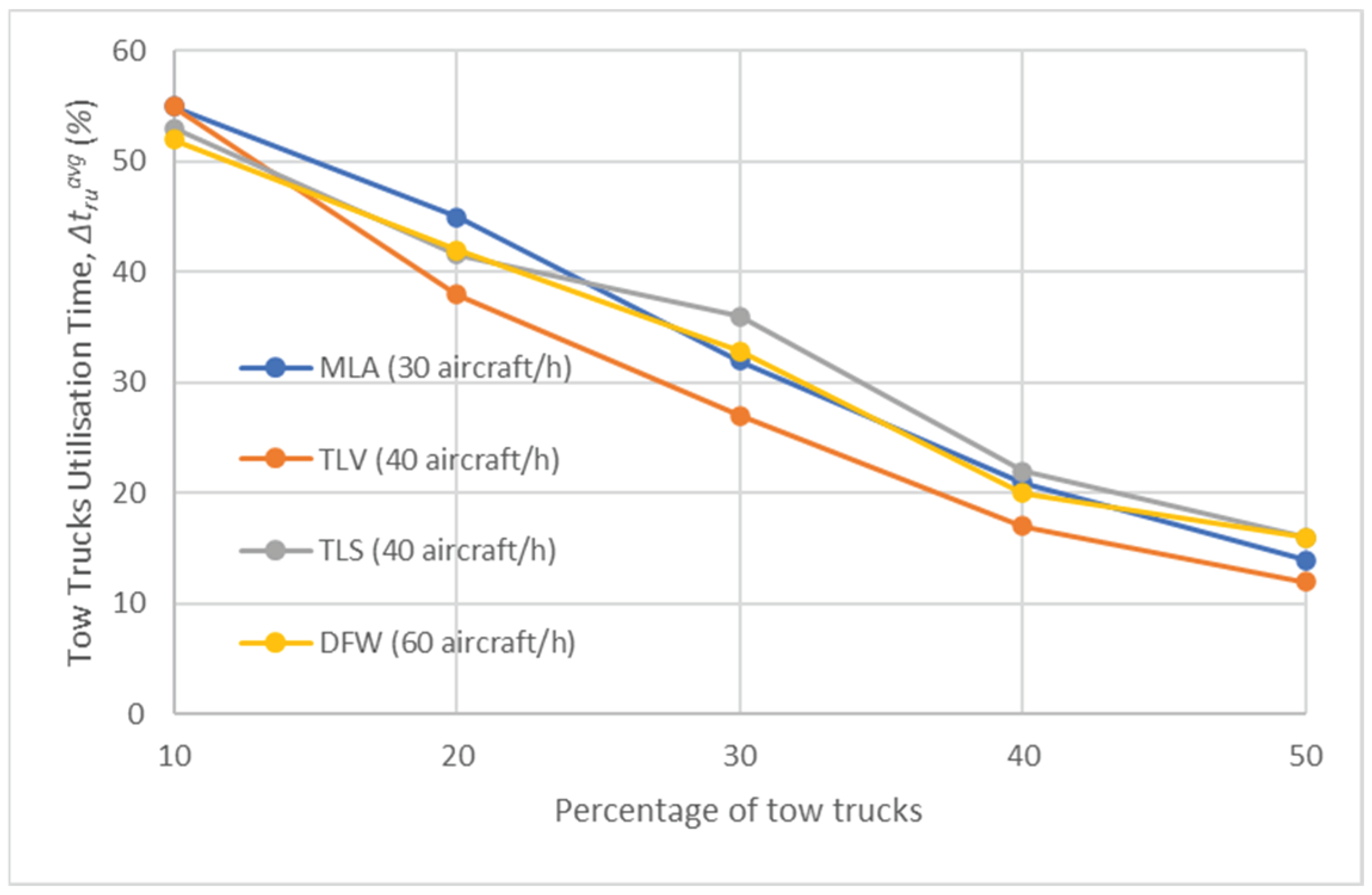
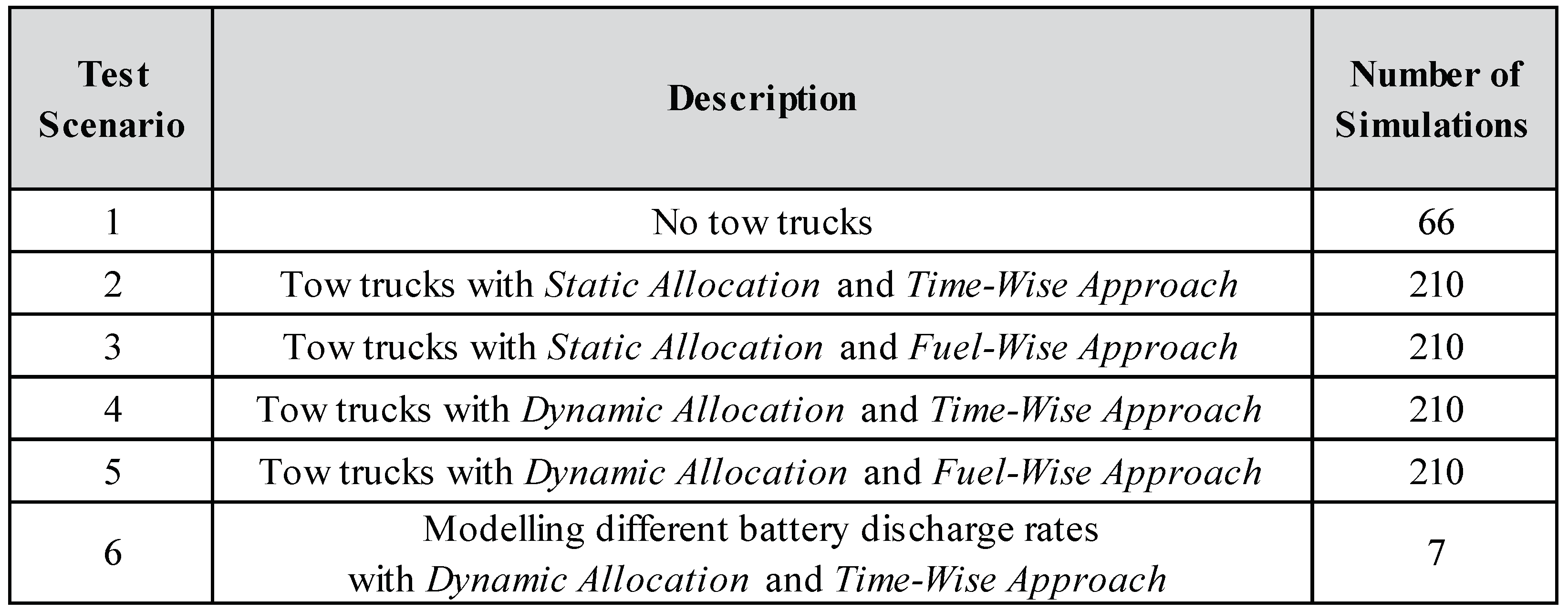 |
| Discharge rates percentage variation (%/min) |
rbdh (%/min) |
rbdl (%/min) |
TA (%) |
ΔFsavg (kg) |
Δtruavg (%) |
|---|---|---|---|---|---|
| -0.75 | 1.25 | 0.25 | 85 | 337 | 45 |
| -0.50 | 1.50 | 0.50 | 83 | 329 | 44 |
| -0.25 | 1.75 | 0.75 | 82 | 325 | 42 |
| 0 | 2.00 | 1.00 | 78 | 315 | 40 |
| +0.25 | 2.25 | 1.25 | 75 | 305 | 39 |
| +0.50 | 2.50 | 1.50 | 72 | 288 | 37 |
| +0.75 | 2.75 | 1.75 | 65 | 258 | 31 |
| +1.00 | 3.00 | 2.00 | 55 | 221 | 27 |
Disclaimer/Publisher’s Note: The statements, opinions and data contained in all publications are solely those of the individual author(s) and contributor(s) and not of MDPI and/or the editor(s). MDPI and/or the editor(s) disclaim responsibility for any injury to people or property resulting from any ideas, methods, instructions or products referred to in the content. |
© 2024 by the authors. Licensee MDPI, Basel, Switzerland. This article is an open access article distributed under the terms and conditions of the Creative Commons Attribution (CC BY) license (http://creativecommons.org/licenses/by/4.0/).





